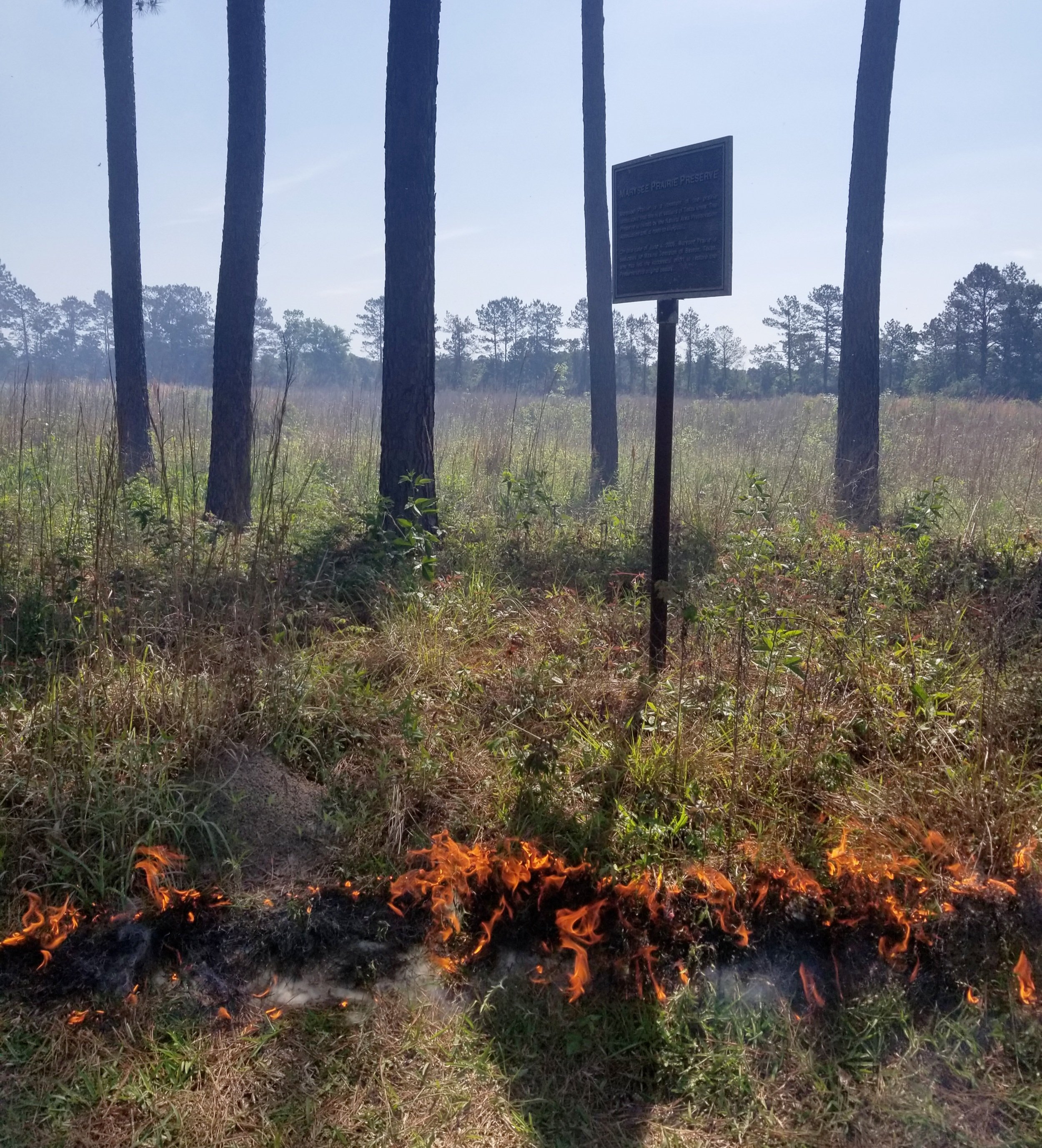For the Good of the Prairie: Burn Baby Burn
In mid-April, TLC had the opportunity to witness our 9-acre unplowed coastal prairie, Marysee Prairie (MSP), undergo a prescribed burn. Historically these coastal prairies were wide ranging all the way up and down the coast of Texas, but the advent of the cow and plow turned much of these prairies into agricultural land. Other areas of coastal prairie (think the Houston area) became sprawling metropolitan areas completely, changing the landscape, hydrology, and species composition. As urban centers and agricultural needs continue to grow, the prairie becomes a more threatened remnant of a historic Texas.
The edge of the burn near the entrance to Marysee Prairie // Ellen Gass
To understand why we intentionally burn these landscapes, we need to go back to a time before Texas was settled. With no one to stop them, wildfires would burn freely until they hit a large enough body of water or the rain diminished the fires. These wildfires likely occurred every 3-5 years in the coastal prairie area naturally causing disturbance and effectively stopping succession. A good way to understand the concept is mowing your grass; if you don’t mow your lawn, eventually it will turn into forest. These fires essentially kept the grasses mowed and kept the prairie from turning into forest, which is one major reason we continue to put fire on the ground, so to speak.
Unfortunately, invasive species have become an issue in these prairies. Suburban areas filled with invasive species adorning homes and businesses can wreak havoc on native prairies. Overtime seed is spread into these costal prairies and plants such as Chinese tallowtree (Triadica sebifera), Chinese privet (Ligustrum sinense), and sacred bamboo (Nandina domestica). This has certainly been the case with MSP and a large reason for TLC’s desire and pursuit to keep fire on the ground in the prairie.
Tools used by the burn crew—drip torch and fire rake // Ellen Gass
The burn was conducted by a Certified and Insured Prescribed Burn Manager (CIPBM) to mitigate safety risks and hazards. Using a CIPBM sheds the liability of burning off the landowner and onto the Burn Managers insurance carrier with the added bonus of the burners experience and expertise to conduct the burn. In addition, the tools needed to conduct a burn efficiently aren’t your typical back yard tools. A burn crew needs drip torches (pictured), specialized rakes to create firelanes and fight spot fires, radios to communicate with each other, and water packs to put out fire in unwanted areas.
Marysee Prairie Volunteers (left to right) David Boyd, Brandt Mannchen, Ellen Buchanan, and Naomi D'Amours // Ellen Gass
Goals of the burn at MSP were to knock back woody competition, control invasive species, and increase available soil nutrients. While not all the woody species were turned to ash as one might think, the heat from the fire can girdle the trees—completely killing or just top killing the tree. With that said, follow up treatments can be extraordinarily effective at continuing to control the woody encroachment. This can be achieved by successive burns, mowing, and herbicides, which work to mimic natural grazing by American Bison (Bison bison). Unfortunately, 9-acres is a little small for a real herd of Bison, so we have a “Buffalo Herd”, our loyal group of volunteers dedicated to maintaining the integrity of Marysee Prairie. They typically meet once a month, check out our volunteer page to see when the next workday will be.
Definitions
Disturbance: a change in environmental condition that causes a major change in an ecosystem; i.e. Fire, Flooding, Storms, and other various natural phenomena
Succession: the change of an ecological community over time beginning with a very basic ecosystem growing into a complex ecosystem
Spot Fires: when an ember carried downwind lights a fire outside the prescribed burn area
Girdling: when a fire is hot enough to kill the living tissue on the main trunk of the tree causing death above the girdled area
Before the burn // Ellen Gass
Fire on the prairie // Brandt Mannchen
After the burn // Brandt Mannchen
Burn crew member walking the burn line // Ellen Gass
Two members of the burn crew for Raven Environmental // Ellen Gass








